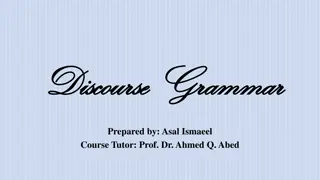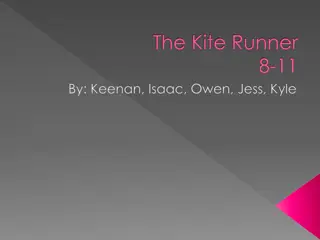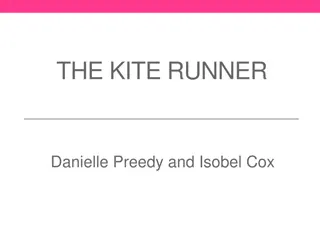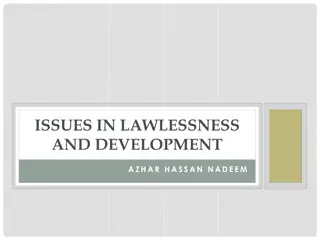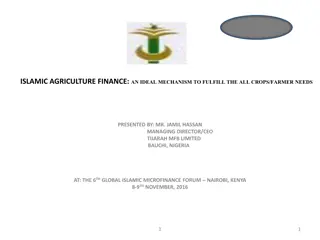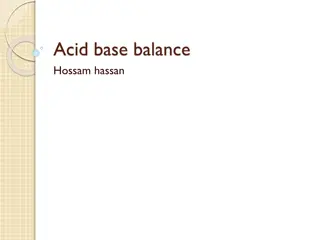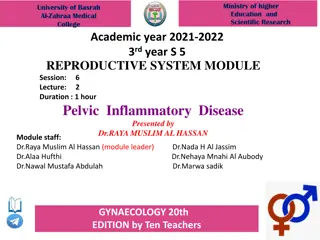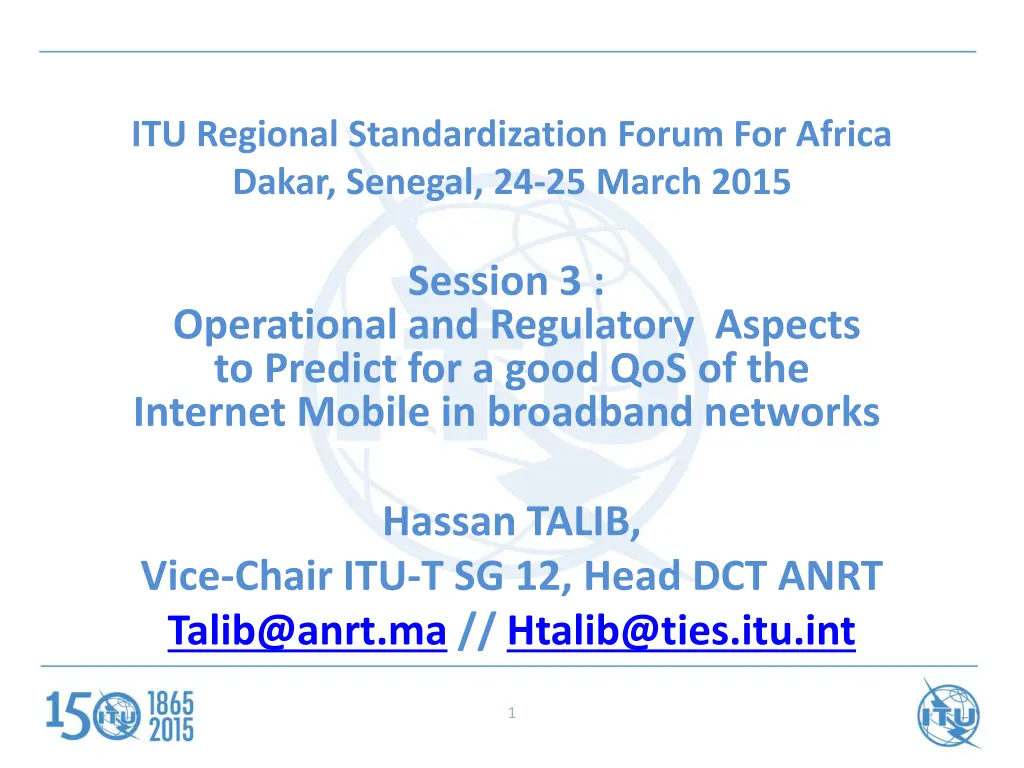
Predicting Quality of Service in Mobile Broadband Networks
Explore the operational and regulatory aspects crucial for ensuring a good Quality of Service (QoS) in mobile Internet within broadband networks. Delve into the general overview, network environments, QoS parameters, and more discussed during the ITU Regional Standardization Forum for Africa in Dakar, Senegal.
Download Presentation

Please find below an Image/Link to download the presentation.
The content on the website is provided AS IS for your information and personal use only. It may not be sold, licensed, or shared on other websites without obtaining consent from the author. If you encounter any issues during the download, it is possible that the publisher has removed the file from their server.
You are allowed to download the files provided on this website for personal or commercial use, subject to the condition that they are used lawfully. All files are the property of their respective owners.
The content on the website is provided AS IS for your information and personal use only. It may not be sold, licensed, or shared on other websites without obtaining consent from the author.
E N D
Presentation Transcript
ITU Regional Standardization Forum For Africa Dakar, Senegal, 24-25 March 2015 Session 3 : Operational and Regulatory Aspects to Predict for a good QoS of the Internet Mobile in broadband networks Hassan TALIB, Vice-Chair ITU-T SG 12, Head DCT ANRT Talib@anrt.ma // Htalib@ties.itu.int 1
Plan of the Presentation General Overview On QoS of the mobile Internet Operational Aspects Regulatory Aspects (ITU-T standards and recommendations) Regulatory Aspects at the national level Conclusions and recommendations 2 Senegal, Dakar, March 24-25, 2015
General Overview on QoS of the Internet Mobile Perimeter of the Presentation Networks concerned: Mobile broadband networks, examples: 3G (UMTS and CDMA2000 ), 4G ( ), Wifi Outdoor (offloading ) ,... Service concerned: Mobile Internet on mobile broadband networks. 3 Senegal, Dakar, March 24-25, 2015
General Overview on QoS of the Internet Mobile General Environment of the QoS Services under Internet: - Data * - Videos * - VoIP - ... * Concerned by this presentation Internet QoS https://www.facebook.com/images/fb_icon_325x325.png https://g.twimg.com/Twitter_logo_blue.png QoS And OTTs : 4 Senegal, Dakar, March 24-25, 2015
General Overview On QoS Of the Internet Mobile General Environment of the QoS Reference : The Recommendation Rec. G. 1000. Subscriber Operator/Provider (Theoretical/imaginary) Difficult to deploy QoS Offered By The operator/Provider QoS Expected By the Users (Operational/actual) a methodology for measuring and evaluation is necessary QoS Issued By the operator/Provider QoS Such that perc eived By The subscriber 5 Senegal, Dakar, March 24-25, 2015
General Overview On QoS Of the Internet Mobile Parameters of services "data" Example of Cause Parameter Example of consequences Example of influence QoS/QoE Errors Of transmission Retransmission Of Packets Delay In the navigation Flow low Download Loss Of Packets Files Of waiting, congestion Delay In the real-time applications Impossibility To play online Offset of a image of CCTV Latency (End-to-end delay) Use of different paths algorithms of different queuing in the nodes The Stack do not arrive in the correct order Delay In the navigation flow low download . Jitter 6 Senegal, Dakar, March 24-25, 2015
General Overview On QoS Of the mobile Internet Parameters of services "video" Parameter Of cause Time of onset of the first image slow Sizing the buffer Example Example of consequences Example of influence QoS/QoE Bad Great expectations before the start of the image Great expectations before the start of the image Server Congestion Link to slow transmissions Flow of the non-continuous video video stop offset of the video Availability of video The resolution and Frame-rate (Image by sec) Bad Delays, stop of the Video Transmission Channel insufficient to route the video Sizing of the resolution in relation to the user flow Bad compression therefore more data Transmission Channel insufficient to route the video The Codec used Delays, stop of the video Poor delivery of the video The application of reading is poorly designed/configured Bad Cut, stop of the video synchronization of flows 7 Senegal, Dakar, March 24-25, 2015
Plan of the presentation General Overview On QoS Of the mobile Internet Operational Aspects Regulatory Aspects (ITU-T standards and recommendations) Regulatory Aspects at the national level Conclusions And recommendations 8 Senegal, Dakar, March 24-25, 2015
Operational Aspects Services and classes of a UMTS network The resources of the networks are allocated and managed according to the profile of QoS for each service. 9 Senegal, Dakar, March 24-25, 2015
Operational Aspects Classes of a UMTS network 10 Senegal, Dakar, March 24-25, 2015
Operational Aspects QoS Flow Chart of the Video Calling service Reference : The Recommendation Rec. ITU-T P. 1301. Start Telemeeting With texts and graphics Communication mode including text / graphics (e. g., web conferencing) ? Yes ITU-T P.1301 Annex B No Telemeeting With the video only Audio Video Communication mode? ITU-T P.1301 Annex C Audio- visual Test mode = audio Test mode = video Audio Video Test mode? Audio-visual Type of quality? Type of quality? Type of quality? Non- inter- active Non- inter- active Non- inter- active Conver- sational Conver- sational Conver- sational Special test method required Continue with Flowchart B Continue with Flowchart C Continue with Flowchart D Continue with Flowchart E Continue with Flowchart F P.1301(12)_FA Senegal, Dakar, March 24-25, 2015
Operational Aspects QoS Tests Architecture of Web service Reference : The Recommendation Rec. P. 1501. Senegal, Dakar, March 24-25, 2015
Operational Aspects QoS Architecture in a LTE network -is established at the initial connection of the equipment to the network. -remains established as long as the service has not changed. A subscriber may have multiple DefaultB each with an IP address. Dedicated Bearer : -is established when there is a need to ensure a level of QoS for a service: VoIP, Visio, Video,... -This is the equivalent of a dedicated tunnel for one or several traffics. It is based on the IP of the Default Bearer. A BEarer is a transmission medium of user traffic of signalling with the characteristics, transport attributions ,treatmentof data and the resources allocated across the network: priority, flow, level of quality, ... Two types of treatment have been defined. Default BEarer : 13 Senegal, Dakar, March 24-25, 2015
Operational Aspects Examples of QoS Indicators of Values in a LTE network The Dedicated Bearers include two categories: GBR: warranted debit Non-GBR: unwarranted debit Senegal, Dakar, March 24-25, 2015
Operational Aspects Architecture of end to end QoS Evaluation in a broadband network End-TB-End Service Quality Public Inter net Internet Service Provide r Network Access Network NTP Local Switch Physical Access Transit Download And Upload Speeds Internet Co ntent Provi ders Gateway Line Termination End User 15 Senegal, Dakar, March 24-25, 2015
Plan of the Presentation General Overview On QoS Of the mobile Internet Operational Aspects Regulatory Aspects ITU-T (standards and recommendations) Regulatory Aspects at the national level Conclusions And recommendations 16 Senegal, Dakar, March 24-25, 2015
Regulatory Aspects ITU-T General Framework The ITU-T recommendations under the SG12 dealing with the QoS/QoE E. 420-E. 479, E. 800-E. 859 G. 100-series, Except G. 160-, G. 180- and G. 190-series G. 1000-series I. 350-series (Including Y. 1501/G. 820/I. 351), I. 371, I. 378, I. 381 P-Series, Except P. 900-series Y. 1220-, Y. 1530-, Y. 1540-, Y. 1560-series 17
Regulatory Aspects ITU-T General Framework The levels of the QoS Network Availability Layer 1 Network Accessibility Layer 2 circuit switched packet switched Service Accessibility Service Integrity Service Retainability Layer 3 Mobile Broadcast File E-Mail MMS Ping Transfer Video Telephony Layer 4 PoC SMS Streaming Telephony Web Browsing 18 Senegal, Dakar, March 24-25, 2015
Regulatory Aspects ITU-T General Framework Reference : The Recommendation Rec. G. 1000. Framework Model of Satisfaction Operator/Provider Subscriber Waiting of the subscriber Waiting QoS Expected By the Users QoR QoS offered by The operator/provider QoO Waiting Review Satisfaction Of the subscriber Non Satisfaction QoS Such that perceiv ed by the subscriber QOP QoS issued by the operator/Provider QoS Perceived Utility Perception of the Subscriber ITU-T G. 1000 K Q I Methodology Four Models of the Market SCAL (KQI) Performance Model Network Availability Customer Care Content Service Network QoS Universal Model Service Utility ACF Model CSAT Model CSAT E. 802 E. QoS Model 803 Senegal, Dakar, March 24-25, 2015
Regulatory Aspects ITU-T Categories of the QoS of Multimedia services/Internet Reference : The Recommendations Rec. ITU-T G. 1010 and G. 1050. In implementation of the relevant recommendations of the ITU-T including the G. 1010 and G. 1050, we can establish guidelines concerning the requirements in terms of performance, the end user's point of view, about the different applications and aggregate them in a set of categories: numbering to (8). The categorization is based on the following parameters: The Delay and the losses of Packets ; The variation of the delay (jitter). Senegal, Dakar, March 24-25, 2015
Regulatory Aspects ITU-T Categories of the QoS of Multimedia services/Internet Reference : The Recommendations Rec. ITU-T G. 1010 and G. 1050. Error tolerant Conversational voice and video Voice/video messaging Streaming audio and video Fax Transactions (eg E-commerce, WWW browsing, Email access) Command/control (eg Telnet, interactive games) Messaging, Downloads (eg FTP, still image) Error intolerant Background (eg Usenet) Interactive (delay <<1 sec) Responsive (delay ~2 sec) Timely Non-critical (delay >>10 sec) (delay ~10 sec) Senegal, Dakar, March 24-25, 2015
Regulatory Aspects ITU-T Categories of the QoS of Multimedia services/Internet Reference : The Recommendations Rec. ITU-T G. 1010 and G. 1050. Packet Loss 5% Voice/video messaging Conversational voice and video Streaming audio/video Delay 100 msec 1 sec 10 sec Fax Background (eg Usenet) 100 sec 0% Command / control (eg Telnet, Interactive games) Messaging, Downloads (eg FTP, still image) Transactions (eg E-commerce, Web-browsing, E- mail access) Zero loss Senegal, Dakar, March 24-25, 2015
Regulatory Aspects ITU-T Modeling of the QoS of Multimedia services/Internet There are five types of objective evaluation models of the Multimedia/Internet quality: Perceptual Models: The input to the model is the media itself (audio and video signals). Parametric Models: The input to the model is the information from the flow of packets and the state of customer information. additional Information such as the type of codec and the binary debit. A parametric model also requires Models of stream of bits: The input to the model is a piece of information derived from the flow and other information pertaining to the packets. The hybrid models: The input to the model is the flow of the packets. Perhaps also information pertaining to the status of the client. Planning Models: The input to the model includes the parameters for planning of the quality of Networks. It usually requires a prior knowledge of the testing. Senegal, Dakar, March 24-25, 2015
Regulatory Aspects ITU-T Modeling of the QoS of Multimedia services/Internet Summary of the models of the ITU-T: Through (CONV) /Non- Through (NONC ONV) Objective test methodology Subjective Test methodology Application Media Primary use Model FR/RR/NR (ITU-T P. 862) + (ITU-T P. 862.1 ] (NB) (ITU-T P. 862.2 ] (WB) (ITU-T P. 863] (NB/WB/SWB) (ITU-T P. 563] (NB) (ITU-T P. 564] (NB/WB) (ITU-T G. 107] (NB) (ITU-T P. 561) + (ITU-T P. 562] (NB/WB) (ITU-T G. 1070] (NB/WB) (ITU-T P. 800] (ITU-T P. 830] (ITU-T P. 835] (ITU-T P. 1301] FR LAB, MY NONCONV Telephony Speech NR MY NR PLN (ITU-T P. 800] (ITU-T P. 805] (ITU-T P. 1301] CONV NR MY (ITU-T P. 920] (ITU-T P. 1301] Multimedia (Note) Video telephony CONV NR PLN Senegal, Dakar, March 24-25, 2015
Regulatory Aspects ITU-T Modeling of the QoS of Multimedia Summary of the models of the ITU-T: services/Internet Through (CONV) /Non- Through (NONC ONV) Objective test methodology Subjective test methodology Application Media Model FR/RR/NR Primary use (ITU-T J. 144] (SD) (ITU-T J. 247] (QCIF, CIF, VGA) (ITU-T J. 341] (HD) (ITU-T J. 249] (SD) (ITU-T J. 246) (QCIF, CIF, VGA) (ITU-T J. 342] (HD) FR LAB, MY (ITU-T P. 910] (ITU-T J. 140] [ITU-R BT.500-1 STANDARD3] Video NONCONV RR MY (ITU-T P. 830] [ITU-R BS.1116-1] [ITU-R BS.1285] [ITU-R BS.1534-1] Video streaming (Mobile TV/IPTV) Audio NONCONV [ITU-R BS.1387] FR/RR MY/PLN (ITU-T P. 1201.1 ] (QCIF, QVGA, HVGA) (ITU-T P. 1201.2 ] (SD, HD) (ITU-T P. 1202.1 ] (QCIF, QVGA, HVGA) (ITU-T P. 1202.2 ] (SD, HD) (ITU-T G. 1030] Multimedia NONCONV (ITU-T P. 911] NR MY Web browsing Data NR PLN Senegal, Dakar, March 24-25, 2015
Plan of the presentation General Overview On QoS Of the mobile Internet Operational Aspects Regulatory Aspects (ITU-T standards and recommendations) Regulatory Aspects at the national level Conclusions And recommendations 26 Senegal, Dakar, March 24-25, 2015
Regulatory Aspects at the national level Provisions to provide by the regulator in the specifications/licensing of operators of broadband networks Examples of parameters for administrative QoS : Parameter (Unit) Example of value (1EraYear) Example of value (2ThYear) Conformity of the network and the equipment to international standards (ITU) -------------------- -------------------- Permanence of Services (time and day) 24/24 AND 7/7 24/24 AND 7/7 Cumulative Duration of unavailability of a base station must not exceed per year a duration (hour) 24 12 Obligation of investment for more capacities to connect to the international (Gbps) 200 400 Deadline for operating (in time) 5 OR 7 4 Time of servicing failures (hour) 24 12 Rate of litigation on invoices ( %) 0.5 0.4 27 Senegal, Dakar, March 24-25, 2015
Regulatory Aspects at the national level Provisions to provide by the regulator in the specifications/licensing of operators of broadband networks Examples of parameters for technical QoS QoSQoS Techniques: Parameter (Unit) Example of value (1EraYear) Example of value (2ThYear) Success Rate of the first attempt ( %) 95 98 Rate of successful connections in a fixed deadline (5 To 15s in relation to the network) ( %) 96 OR 98 98 OR 99 The downflow average minimum required for 90% of the population covered (Mbps) 2 Or 4 4 OR 7 Rate cut downloading or uploading ( %) 5 3 Average time to start the video (s) 10 15 Maximum number of stops of the video (figure) 3 1 28 Senegal, Dakar, March 24-25, 2015
Conclusions and Recommendations The requirement to establish a regulatory framework for the QoS for broadband networks at the national level. QoS for Internet in a context of mutation: NGN network all IP, IoT, IPv6, MTOM,... QoS for Internet at two speeds. Divergent Positions USA, Europe, ICANN,... OTTs And QoS : Problems of distributing the responsibilities? 29 Senegal, Dakar, March 24-25, 2015
Thank you for your attention Questions/Answers Talib@anrt.ma // Htalib@ties.itu.int 30 Senegal, Dakar, March 24-25, 2015


